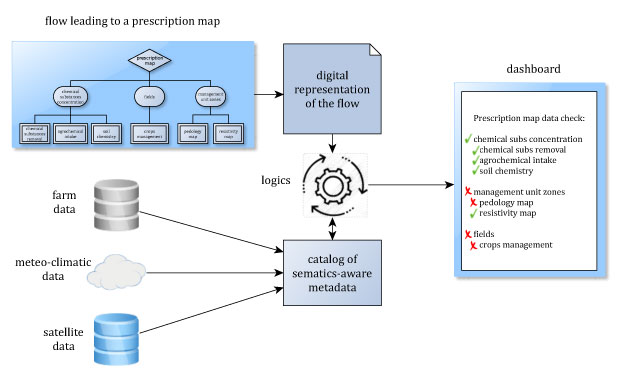by Simone Lanucara, Cristiano Fugazza, Paolo Tagliolato and Alessandro Oggioni (CNR-IREA)
Implementing a semantics-aware dashboard allowing for automated flagging of missing data.
Precision agriculture (PA) is increasingly becoming a data-intensive discipline characterised by the collection and processing of digital data whose level of granularity is augmenting day by day. On the one hand, individual in-the-field activities are becoming increasingly accurately traced (e.g., via telemetry); on the other, digitally collected information can be exploited by in-silico models in order to suggest actions to farmers. In this scenario, data management must be capable of considering heterogeneous sources, either site-specific information directly collected by farmer’s devices or derived from these and external data sources, such as meteorological data and satellite data. Major issues in the advancement of PA include articulating and understanding the huge amount of data that is collected and implementing sound strategies for field management. However, most data and information sources are fragmented, encoded in different formats, and awkward to find and use. It is then necessary to structure and harmonise information in order to check which data are available, what are they for, and their sources. Once this information is made available, it is possible to process data in order to obtain more refined data products.
The integration of heterogeneous data from multiple sources is major issue in the domain of spatial information technology. Different approaches (see [1] for a review of these) propose Service Oriented Architectures (SOA) to ease integration of heterogeneous and distributed sources for PA; as implemented in other domains (geologic, oceanographic, ecological), SOA enable web sharing of data and related metadata. In the context of the SATFARMING project, in order to foster interoperability, we are implementing a semantically enabled SOA based on Open Geospatial Consortium (OGC) standards. The SATFARMING project, funded by a private company, IBF Servizi S.p.A., is addressing the aforementioned issues in a comprehensive way. The SOA takes into account PA models, workflows, and processes through diverse software components, services, and tools accelerating integration of data-sources, and their processing, creating PA data products and sharing them.
In SATFARMING, in addition to allowing for harmonisation, management, identification, and sharing of multi-temporal, multi-scale, and external data sources, we formalise the flows leading to PA products in terms of the necessary data and processes, enabling automated flagging of missing inputs in a user-friendly web-based dashboard. The first application scenario is constituted by prescription maps, PA products specifying the actions (in terms of what, where, and when) the farmer shall execute on a given field. Figure 1 depicts the transitions leading from abstract flows and heterogeneous data sources to the synoptic dashboard pinpointing the missing components for processing the data product constituting prescription maps. On the one hand, the abstract flow is translated into a digital representation that is amenable to processing (upper-left side); on the other, the heterogeneous data sources are collected and annotated (bottom-left side). Both these activities are supported by the controlled vocabulary that allows their representations to be semantically enriched. The added semantics allows logics to process these data structures in order to cross-reference them and compute the dashboard on the right-hand side of the Figure.

Figure 1: Semantics-aware dashboard in the SATFARMING SOA.
The dashboard presented here is implemented as a component of the SOA being developed in the SATFARMING project; hence it is readily available via the mechanisms defined by SOA. As an example, the component could be exploited for dissemination of PA knowledge (models, workflows and products) from PA-savvy agronomists to agronomists in developing countries who do not have first-hand experience of these techniques. Agronomists with expertise in this area may define the flow leading to a given PA product so that an inexperienced agronomist can understand, by using the dashboard, which data and processing are required to achieve the final PA product. This is in line with the United Nations 2030 Agenda on Zero Hunger Goal which aims to: 1) ensure sustainable food production systems, 2) implement resilient agricultural practices that increase production, and 3) improve agricultural productivity of small-scale food producers.
References:
[1] Janssen et al.:”Towards a New Generation of Agricultural System Data, Models and Knowledge Products: Information and Communication Technology.” Agricultural Systems 155. 2017
Please contact:
Simone Lanucara, CNR-IREA, Italy
+39 3496082982











